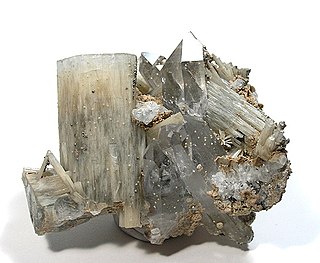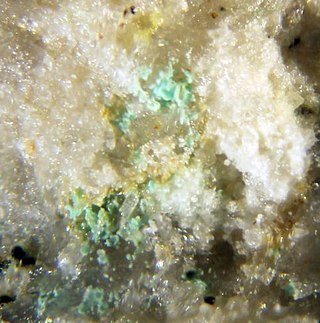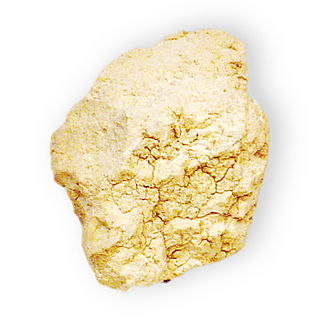
Sillimanite is an aluminosilicate mineral with the chemical formula Al2SiO5. Sillimanite is named after the American chemist Benjamin Silliman (1779–1864). It was first described in 1824 for an occurrence in Chester, Connecticut.

Acanthite is a form of silver sulfide with the chemical formula Ag2S. It crystallizes in the monoclinic system and is the stable form of silver sulfide below 173 °C (343 °F). Argentite is the stable form above that temperature. As argentite cools below that temperature its cubic form is distorted to the monoclinic form of acanthite. Below 173 °C acanthite forms directly. Acanthite is the only stable form in normal air temperature.

Zinnwaldite, KLiFeAl(AlSi3)O10(OH,F)2, potassium lithium iron aluminium silicate hydroxide fluoride is a silicate mineral in the mica group. The IMA status is as a series between siderophyllite (KFe2Al(Al2Si2)O10(F,OH)2) and polylithionite (KLi2AlSi4O10(F,OH)2) and not considered a valid mineral species.

Cooperite is a grey mineral consisting of platinum sulfide, generally in combinations with sulfides of other elements such as palladium and nickel. Its general formula is (Pt,Pd,Ni)S. It is a dimorph of braggite.

Allanite (also called orthite) is a sorosilicate group of minerals within the broader epidote group that contain a significant amount of rare-earth elements. The mineral occurs mainly in metamorphosed clay-rich sediments and felsic igneous rocks. It has the general formula A2M3Si3O12[OH], where the A sites can contain large cations such as Ca2+, Sr2+, and rare-earth elements, and the M sites admit Al3+, Fe3+, Mn3+, Fe2+, or Mg2+ among others. However, a large amount of additional elements, including Th, U, Be, Zr, P, Ba, Cr and others may be present in the mineral. The International Mineralogical Association lists four minerals in the allanite group, each recognized as a unique mineral: allanite-(Ce), allanite-(La), allanite-(Nd), and allanite-(Y), depending on the dominant rare earth present: cerium, lanthanum, neodymium or yttrium.

Hausmannite is a complex oxide of manganese containing both di- and tri-valent manganese. The formula can be represented as Mn2+Mn3+2O4. It belongs to the spinel group and forms tetragonal crystals. Hausmannite is a brown to black metallic mineral with Mohs hardness of 5.5 and a specific gravity of 4.8.

Lithiophilite is a mineral containing the element lithium. It is lithium manganese(II) phosphate with chemical formula LiMnPO4. It occurs in pegmatites often associated with triphylite, the iron end member in a solid solution series. The mineral with intermediate composition is known as sicklerite and has the chemical formula Li(Mn,Fe)PO4). The name lithiophilite is derived from the Greek philos (φιλός) "friend," as lithiophilite is usually found with lithium.

Sugilite ( SOO-gə-lyte, -jee-) is a relatively rare pink to purple cyclosilicate mineral with the complex chemical formula KNa2(Fe, Mn, Al)2Li3Si12O30. Sugilite crystallizes in the hexagonal system with prismatic crystals. The crystals are rarely found and the form is usually massive. It has a Mohs hardness of 5.5–6.5 and a specific gravity of 2.75–2.80. It is mostly translucent. Sugilite was first described in 1944 by the Japanese petrologist Ken-ichi Sugi (1901–1948) for an occurrence on Iwagi Islet, Japan, where it is found in an aegirine syenite intrusive stock. It is found in a similar environment at Mont Saint-Hilaire, Quebec, Canada. In the Wessels mine in Northern Cape Province of South Africa, sugilite is mined from a strata-bound manganese deposit. It is also reported from Liguria and Tuscany, Italy; New South Wales, Australia and Madhya Pradesh, India.

Kolbeckite (scandium phosphate dihydrate) is a mineral with formula: ScPO4·2H2O. It was discovered originally at Schmiedeberg, Saxony, Germany in 1926 and is named after Friedrich L. W. Kolbeck, a German mineralogist. Kolbeckite is usually found as small clusters of crystals associated with other phosphate minerals.
Zincobotryogen is a hydrous sulfate mineral with the chemical formula (Zn,Mg,Mn)Fe3+(SO4)2(OH)·7H2O. It forms bright orange red monoclinic prismatic crystals that exhibit a vitreous to greasy luster. Its specific gravity is 2.201 and it has a Mohs hardness of 2.5.

Cesbronite is a copper-tellurium oxysalt mineral with the chemical formula Cu3Te6+O4(OH)4 (IMA 17-C). It is colored green and its crystals are orthorhombic dipyramidal. Cesbronite is rated 3 on the Mohs Scale. It is named after Fabien Cesbron (born 1938), a French mineralogist.

Aluminosilicate minerals are minerals composed of aluminium, silicon, and oxygen, plus countercations. They are a major component of kaolin and other clay minerals.

Neptunite is a silicate mineral with the formula KNa2Li(Fe2+, Mn2+)2Ti2Si8O24. With increasing manganese it forms a series with mangan-neptunite. Watatsumiite is the variety with vanadium replacing the titanium in the formula.

Hectorite is a rare soft, greasy, white clay mineral with a chemical formula of Na0.3(Mg,Li)3Si4O10(OH)2.
Anandite is a rare phyllosilicate with formula (Ba,K)(Fe2+,Mg)3(Si,Al,Fe)4O10(S,OH)2. It crystallizes in the monoclinic crystal system. It is black in color with a glassy luster and a near perfect cleavage.

Imogolite is an aluminium silicate clay mineral with the chemical formula Al2SiO3(OH)4. It occurs in soils formed from volcanic ash and was first described in 1962 for an occurrence in Uemura, Kumamoto prefecture, Kyushu Region, Japan. Its name originates from the Japanese word imogo, which refers to the brownish yellow soil derived from volcanic ash. It occurs together with allophane, quartz, cristobalite, gibbsite, vermiculite and limonite.

Strashimirite (IMA symbol: Ssh) is a rare monoclinic mineral containing arsenic, copper, hydrogen, and oxygen. It has the chemical formula Cu8(AsO4)4(OH)4·5(H2O).
Aspidolite is a mica group phyllosilicate mineral which is the sodium analogue of the magnesium-rich mineral phlogopite. The ideal chemical formula for aspidolite is NaMg3AlSi3O10(OH)2.

Strunzite (Mn2+Fe3+2(PO4)2(OH)2{{·}}6H2O) is a light yellow mineral of the strunzite group, first discovered in 1957.
















